




Looking to get fit and toned with a simple yet effective workout plan? Look no further than a 12-week dumbbell workout plan PDF here!
Say goodbye to monotony and embrace the power of dumbbells as we embark on this exhilarating training adventure together.
Key Takeaways
- Dumbbell workouts target specific muscle groups like the back, arms, shoulders, chest, and legs, leading to increased strength across various areas of the body.
- Regular dumbbell exercises enhance muscular endurance, which can help reduce fatigue during everyday tasks and physical activities.
- Dumbbell workouts promote stability, balance, flexibility, and range of motion by engaging in stabilizing muscles and supporting joint health.
- The versatility and convenience of dumbbells make them suitable for both home and gym workouts, offering a wide range of exercises to improve overall fitness.
- Incorporating functional strength exercises using dumbbells can benefit daily activities and sports performance, promoting an active and healthy lifestyle.
What Are The Benefits Of Dumbbell Workouts?
Dumbbell workouts offer a wide range of benefits for physical fitness and other strength training exercises. Some of the key benefits include:
- Versatility: Dumbbell workouts offer versatility, allowing you to perform a wide range of exercises targeting various muscle groups, from the upper body to the lower body and core.
- Strength Development: Dumbbell exercises help build strength and muscle mass by providing resistance in a controlled manner, promoting muscle growth and functional strength.
- Balance and Stability: Using dumbbells requires stabilization, which helps improve balance and coordination, as well as engaging stabilizer muscles for overall stability.
- Convenience: Dumbbells are portable and can be used at home or in the gym, making them a convenient option for strength training workouts anytime, anywhere.
- Joint Health: Dumbbell workouts allow for a full range of motion, promoting joint health and flexibility while reducing the risk of injury compared to fixed machines.
Best 4 Exercises to Include in Your Dumbbell Workout Plan
Since you now know the benefits of incorporating dumbbells into your workouts, what exercises can you include?
Here we have listed 4 types of exercises that are effective and that you may consider including:
Dumbbell Squats
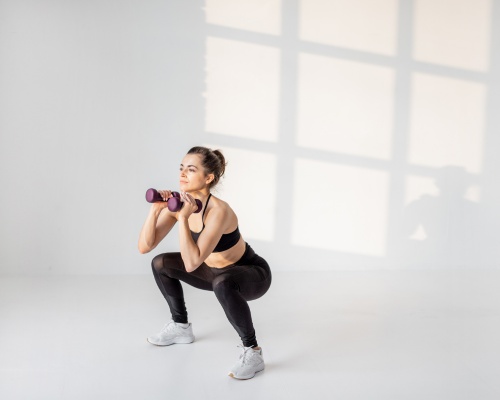
Dumbbell squats are a compound lower body exercise that targets the quadriceps, hamstrings, glutes, and core muscles.
How to do it:
- Hold a dumbbell in each hand, standing with your feet shoulder-width apart.
- Keep your back straight and chest up as you lower yourself into a squat position, ensuring your knees do not go past your toes.
- Push through your heels to return to the starting position.
- Dumbbell squats target the legs, glutes, and core muscles.
Dumbbell Bent-Over Rows
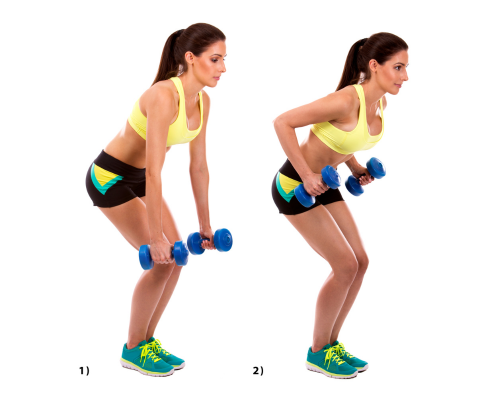
Dumbbell bent-over rows are an effective back exercise that targets the lats, rhomboids, rear deltoids, and biceps.
How to do it:
- Grasp a dumbbell in each hand, and bend at the hips to lean forward while maintaining a straight back.
- Pull the dumbbells towards your ribcage, squeezing your elbows close to shoulder blades together at the top of the movement.
- Lower the dumbbells back down with control.
- Dumbbell bent-over rows target the upper back, shoulders, and biceps.
Dumbbell Chest Press
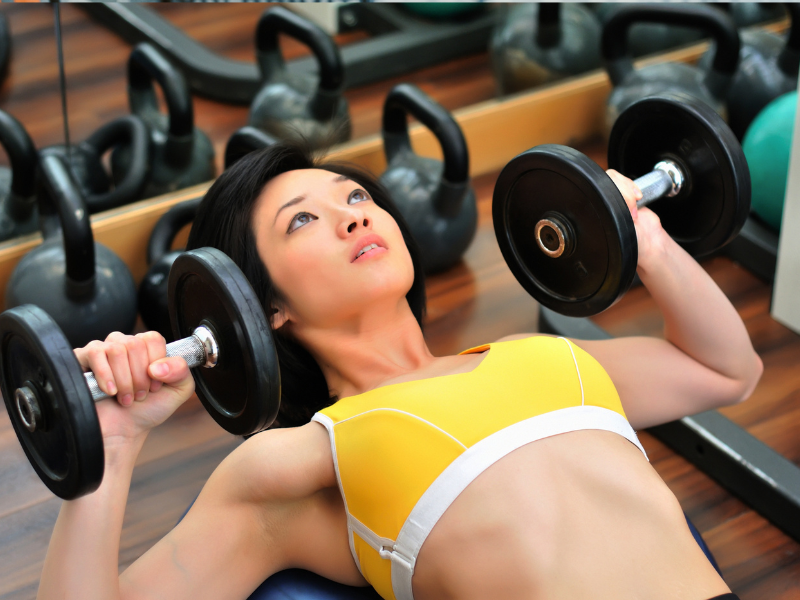
The dumbbell chest press is a classic upper-body exercise that primarily targets the chest, shoulders, and triceps.
How to do it:
- Lie on a bench with a dumbbell in each hand, palms facing away from you.
- Extend your arms straight up over your chest, then lower the dumbbells down towards your sides.
- Press the dumbbell back up to the starting position.
- Dumbbell chest presses target the chest, shoulders, and triceps.
Dumbbell Lunges
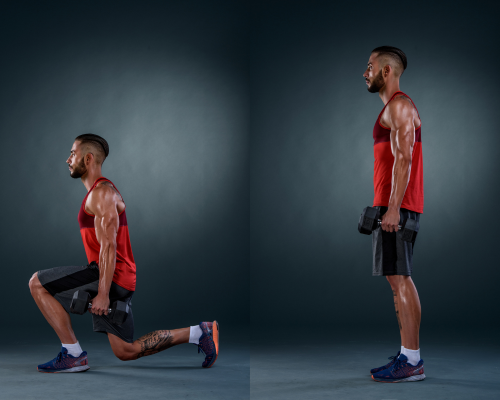
Dumbbell lunges are a unilateral lower-body exercise that targets the quadriceps, hamstrings, glutes, and calves, as well as improves balance and coordination.
How to do it:
- Hold a dumbbell in each hand at your sides, standing tall.
- Advance with one leg and lower your body until both knees form 90-degree angles.
- Push through the front heel to return to the starting position.
- Dumbbell lunges target the legs, back muscles glutes, and core muscles.
These exercises provide a well-rounded workout focusing on major muscle groups. Ensure you uphold correct form, begin with a weight that pushes you while still enabling proper technique, and incrementally raise the weight as you enhance your strength.
The Dumbbell Workout Guide
Designing an effective dumbbell workout guide involves incorporating a variety of exercises that target different muscle groups, ensuring balance, progression, and proper form. Here is an ultimate dumbbell workout guide to help you achieve your fitness goals:
Warm-Up:
Begin your session with a 5-10 minute dynamic warm-up, aimed at enhancing blood circulation and priming your muscles for the upcoming workout. Incorporate dynamic movements such as arm circles, leg swings, and bodyweight squats to effectively prepare your body for optimal performance.
Workout Structure:
Full-Body Circuit:
- Perform 3-4 sets of each exercise
- 8-12 repetitions per set
- 30-60 seconds rest between sets
Choose from the following exercises:
Upper Body:
- Dumbbell Bench Press
- Bent-Over Rows
- Shoulder Press
- Bicep Curls
- Tricep Extensions
Lower Body:
- Goblet Squats
- Lunges
- Deadlifts
- Calf Raises
Core:
- Russian Twists
- Planks
- Bicycle Crunches
Cool Down
Finish with a 5-10 minute cooldown that includes static stretching for all major muscle groups. This helps reduce muscle soreness and improve flexibility.
Beginners Dumbbell Workout Plan

Here’s a simple and effective 4-week beginner dumbbell workout plan to help you get started on your fitness journey. This plan focuses on basic movements and gradually increases the challenge over a month.
Bodyweight Warm-up, 3 Rounds
- 15 air squats (optional: jump squat for final round)
- 10 push-ups
- 20 alternating reverse back stepping lunges (optional: jump lunge for final round)
- 20 mountain climbers
- 20 alternating lateral lunges (optional: speed skater for final round)
- 20 jumping jacks
Set 1, 3 Rounds
- 15 dumbbell suitcase squats
- 20 kettlebell or dumbbell swings
- 15 dumbbell Romanian deadlifts
- 15 dumbbell chest flys
Set 2, 3 Rounds
- 15 dumbbell push press
- 15 static lunges, each leg (holding dumbbell on the side of the grounded leg)
- 20 dumbbell alternating kneeling plank rows
- 15 dumbbell donkey kicks, each leg
Set 3, 3 Rounds
- 15 kettlebell or dumbbell goblet squats
- 15 dumbbell bicep curls
- 20 dumbbell alternating curtsy lunges
- 15 dumbbell overhead trice extensions
Core Finisher
- 15 one straight leg/one bent knee crunches, each side
- 30 second side forearm plank, each side
- 60 second forearm plank
- 10 cobra push ups
- 30 second hold in sphinx
12-Week Dumbbell Workout Plan PDF
Here’s a sample 12-week dumbbell workout plan designed to provide a structured progression over the course of three months. This plan focuses on full-body workouts, ensuring balanced muscle development and continuous improvement. Follow the 5-day workout routine for 12 weeks, which requires two rest days for optimal results.

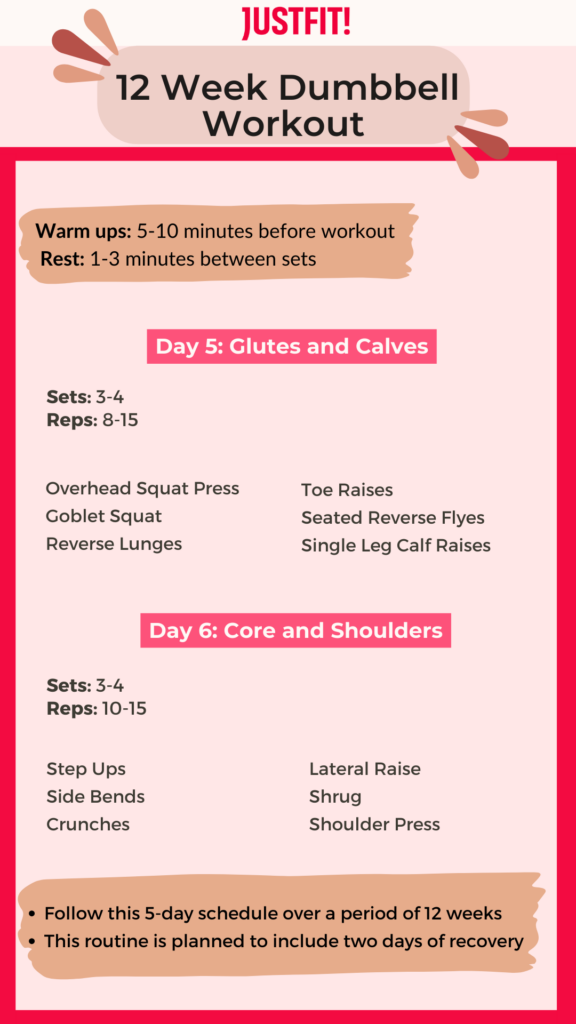
Day 1: Legs and Core (3-4 sets x 8-12 reps)
- Russian Twists
- Bulgarian Split Squats
- Crunches
- Straight Leg Deadlift
- Goblet Squats
- Air Squats
Day 2: Back and Shoulder (3-4 sets x 8-15 reps)
- Upright Row
- Shoulder Press
- Dumbbell Renegade Row
- Side Lateral Raises
- Shrugs
- Bent Over Row
Day 3: Chest (3-4 sets x 8-16 reps)
- Decline DB Bench Press
- Chest Fly
- Dumbbell Pullover
- Chest Press
- Underhand DB Bench press
Day 4: Glutes and Calves (3-4 sets x 8-15 reps)
- Overhead Squat Press
- Goblet Squat
- Reverse Lunges
- Toe Raises
- Seated Reverse Flyes
- Single Leg Calf Raises
Day 5: Core and Shoulder (3-4 sets x 8-15 reps)
- Step Ups
- Side Bends
- Crunches
- Lateral Raise
- Shrug
- Shoulder Press
More Dumbbell Workouts Plan
If you want more of these, check out this article:
Selecting Your Dumbbells
A set of dumbbells ranging from 3-10 lbs (1-5 kg) is ideal for developing lean muscle mass and reducing body fat. If you intend to focus on heavy exercises like squats, leg presses, and deadlifts, consider acquiring a 20 lb (9 kg or 10 kg) dumbbell.
As your strength training progresses, increasing the weight of your dumbbells becomes necessary to continually challenge your muscles and witness advancement. It’s generally recommended to incrementally increase the weight by no more than 5-10% at a time and meticulously monitor your form to ensure the correct execution of the exercises.
Tips on Rest and Nutrition
When you decide to start a workout routine that involves dumbbells, you should ensure that you are fuelling your body properly and resting enough. If you want to see results, there has to be a proper balance. Here are some tips:
1. Rest Between Sets
During your dumbbell workouts, it’s crucial to have adequate rest between sets as it allows your muscles to recover slightly before you move on to the next set. Aim for 60-90 seconds of rest between sets to optimize muscle recovery while still keeping your heart rate elevated.
2. Rest Days
Incorporate rest days into your weekly workout schedule to give your body time to recover and repair. Rest days are just as important as workout days and are essential for preventing overtraining and injury. Listen to your body and adjust your rest days as needed based on your energy levels and recovery status.
3. Timing of Meals
Fuel your workouts and support recovery by paying attention to nutrient timing. Eat a balanced meal containing carbohydrates and protein 2-3 hours before your workout to provide energy and support muscle repair. After your workout, consume a post-workout meal or snack rich in protein and carbohydrates to replenish glycogen stores and promote muscle recovery.
See also: 5 Best Plant Based Protein Powder of 2024
4. Hydration
Proper hydration is essential for performance and recovery during your dumbbell workouts. Drink water before, during, and after your workouts to stay hydrated and support optimal muscle function. Aim to drink at least 8-10 glasses of water per day, or more if you’re exercising intensely or in hot weather.
5. Nutrient-Dense Foods
Focus on consuming nutrient-dense foods to fuel your workouts and support overall health. Prioritize lean proteins, whole grains, fruits, vegetables, and healthy fats in your diet to provide the vitamins, minerals, and antioxidants your body needs to thrive.
By prioritizing rest and nutrition, you are sure to optimize your performance, support muscle growth and recovery, and achieve your fitness goals more effectively.
See also: What To Eat Before Workout
Conclusion
In conclusion, integrating dumbbell workouts into a fitness routine provides a multitude of benefits such as increased muscle strength and improved overall physical well-being.
By following structured workout plans, beginners can establish a foundation while advanced trainees can progress towards more challenging exercises over time.
Can I build muscle with just dumbbells?
How long should I perform the dumbbell workout?
Josh England (2018). Dumbbell Only Workout: 5 Day Dumbbell Workout Split. Available at: https://www.muscleandstrength.com/workouts/5-day-dumbbell-only-workout-split [Accessed 9 April 2024].
Andrew Tracey (2023). The Men's Health Dumbbell Club – Your New Weekly Workout Plan. Available at: https://www.menshealth.com/uk/workouts/a44128805/dumbbell-workout-plan/ [Accessed 9 April 2024].
Steve Hoyles (2024). 12 Week Dumbbell Workout Plan – Three Months to Insanity. Available at: https://stronghomegym.com/12-week-dumbbell-workout-plan/ [Accessed 9 April 2024].





